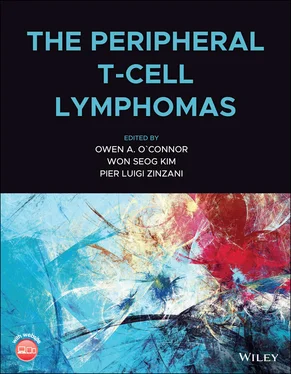19 19 Solary, E., Bernard, O.A., Tefferi, A. et al. (2014). The Ten‐Eleven Translocation‐2 (TET2) gene in hematopoiesis and hematopoietic diseases. Leukemia 28 (3): 485–496.
20 20 Kim, S.J., Zhao, H., Hardikar, S. et al. (2013). A DNMT3A mutation common in AML exhibits dominant‐negative effects in murine ES cells. Blood 122 (25): 4086–4089.
21 21 Cairns, R.A. and Mak, T.W. (2013). Oncogenic isocitrate dehydrogenase mutations: mechanisms, models, and clinical opportunities. Cancer Discov 3 (7): 730–741.
22 22 Lemonnier, F., Poullot, E., Dupuy, A. et al. (2018). Loss of 5‐hydroxymethylcytosine is a frequent event in peripheral T‐cell lymphomas. Haematologica 103 (3): e115–e118.
23 23 Roberti, A., Dobay, M.P., Bisig, B. et al. (2016). Type II enteropathy‐associated T‐cell lymphoma features a unique genomic profile with highly recurrent SETD2 alterations. Nat Commun 7: 12602.
24 24 McKinney, M., Moffitt, A.B., Gaulard, P. et al. (2017). The genetic basis of hepatosplenic T‐cell lymphoma. Cancer Discov 7 (4): 369–379.
25 25 Jiang, L., Gu, Z.H., Yan, Z.X. et al. (2015). Exome sequencing identifies somatic mutations of DDX3X in natural killer/T‐cell lymphoma. Nat Genet 47 (9): 1061–1066.
26 26 Li, Z., Zhang, X., Xue, W. et al. (2019). Recurrent GNAQ mutation encoding T96S in natural killer/T cell lymphoma. Nat Commun 10 (1): 4209–4209.
27 27 Ji, M.M., Huang, Y.H., Huang, J.Y. et al. (2018). Histone modifier gene mutations in peripheral T‐cell lymphoma not otherwise specified. Haematologica 103 (4): 679–687.
28 28 Laurent, C., Nicolae, A., Laurent, C. et al. (2020). Gene alterations in epigenetic modifiers and JAK‐STAT signaling are frequent in breast implant–associated ALCL. Blood 135 (5): 360–370.
29 29 Genovese, G., Kähler, A.K., Handsaker, R.E. et al. (2014). Clonal hematopoiesis and blood‐cancer risk inferred from blood DNA sequence. N Engl J Med 371 (26): 2477–2487.
30 30 Jaiswal, S., Fontanillas, P., Flannick, J. et al. (2014). Age‐related clonal hematopoiesis associated with adverse outcomes. N Engl J Med 371 (26): 2488–2498.
31 31 Quivoron, C., Couronné, L., Della Valle, V. et al. (2011). TET2 inactivation results in pleiotropic hematopoietic abnormalities in mouse and is a recurrent event during human lymphomagenesis. Cancer Cell 20 (1): 25–38.
32 32 Yang, L., Rau, R., and Goodell, M.A. (2015). DNMT3A in haematological malignancies. Nat Rev Cancer 15 (3): 152–165.
33 33 Nel, A.E. (2002). T‐cell activation through the antigen receptor. Part 1: signaling components, signaling pathways, and signal integration at the T‐cell antigen receptor synapse. J Allergy Clin Immunol 109 (5): 758–770.
34 34 Streubel, B., Vinatzer, U., Willheim, M. et al. (2006). Novel t(5;9)(q33;q22) fuses ITK to SYK in unspecified peripheral T‐cell lymphoma. Leukemia 20 (2): 313–318.
35 35 Pechloff, K., Holch, J., Ferch, U. et al. (2010). The fusion kinase ITK‐SYK mimics a T cell receptor signal and drives oncogenesis in conditional mouse models of peripheral T cell lymphoma. J Exp Med 207 (5): 1031–1044.
36 36 Feldman, A.L., Sun, D.X., Law, M.E. et al. (2008). Overexpression of Syk tyrosine kinase in peripheral T‐cell lymphomas. Leukemia 22 (6): 1139–1143.
37 37 Palomero, T., Couronné, L., Khiabanian, H. et al. (2014). Recurrent mutations in epigenetic regulators, RHOA and FYN kinase in peripheral T cell lymphomas. Nat Genet 46 (2): 166–170.
38 38 Fujisawa, M., Sakata‐Yanagimoto, M., Nishizawa, S. et al. (2018). Activation of RHOA‐VAV1 signaling in angioimmunoblastic T‐cell lymphoma. Leukemia 32 (3): 694–702.
39 39 Cortes, J.R., Ambesi‐Impiombato, A., Couronné, L. et al. (2018). RHOA G17V induces T follicular helper cell specification and promotes lymphomagenesis. Cancer Cell 33 (2): 259–273.e7.
40 40 Ng, S.Y., Brown, L., Stevenson, K. et al. (2018). RhoA G17V is sufficient to induce autoimmunity and promotes T cell lymphomagenesis in mice. Blood 132 (9): 935–947.
41 41 Vallois, D., Dobay, M.P.D., Morin, R.D. et al. (2016). Activating mutations in genes related to TCR signaling in angioimmunoblastic and other follicular helper T‐cell‐derived lymphomas. Blood 128 (11): 1490–1502.
42 42 Vaqué, J.P., Gómez‐López, G., Monsálvez, V. et al. (2014). PLCG1 mutations in cutaneous T‐cell lymphomas. Blood 123 (13): 2034–2043.
43 43 Luchtel, R.A., Dasari, S., Oishi, N. et al. (2018). Molecular profiling reveals immunogenic cues in anaplastic large cell lymphomas with DUSP22 rearrangements. Blood 132 (13): 1386–1398.
44 44 Luchtel, R.A., Zimmermann, M.T., Hu, G. et al. (2019). Recurrent MSCE116K mutations in ALK‐negative anaplastic large cell lymphoma. Blood 133 (26): 2776–2789.
45 45 Cristofoletti, C., Picchio, M.C., Lazzeri, C. et al. (2013). Comprehensive analysis of PTEN status in Sézary syndrome. Blood 122 (20): 3511–3520.
46 46 Kataoka, K., Nagata, Y., Kitanaka, A. et al. (2015). Integrated molecular analysis of adult T cell leukemia/lymphoma. Nat Genet 47 (11): 1304–1315.
47 47 Wartewig, T., Kurgyis, Z., Keppler, S. et al. (2017). PD‐1 is a haploinsufficient suppressor of T cell lymphomagenesis. Nature 552 (7683): 121–125.
48 48 Seif, F., Khoshmirsafa, M., Aazami, H. et al. (2017). The role of JAK‐STAT signaling pathway and its regulators in the fate of T helper cells. Cell Commun Signal 15 (1): 23.
49 49 Werner, M.T., Zhao, C., Zhang, Q., and Wasik, M.A. (2017). Nucleophosmin‐anaplastic lymphoma kinase: the ultimate oncogene and therapeutic target. Blood 129 (7): 823–831.
50 50 Crescenzo, R., Abate, F., Lasorsa, E. et al. (2015). Convergent mutations and kinase fusions lead to oncogenic STAT3 activation in anaplastic large cell lymphoma. Cancer Cell 27 (4): 516–532.
51 51 Koskela, H.L.M., Eldfors, S., Ellonen, P. et al. (2012). Somatic STAT3 mutations in large granular lymphocytic leukemia. N Engl J Med 366 (20): 1905–1913.
52 52 Bouchekioua, A., Scourzic, L., de Wever, O. et al. (2014). JAK3 deregulation by activating mutations confers invasive growth advantage in extranodal nasal‐type natural killer cell lymphoma. Leukemia 28 (2): 338–348.
53 53 Watatani, Y., Sato, Y., Miyoshi, H. et al. (2019). Molecular heterogeneity in peripheral T‐cell lymphoma, not otherwise specified revealed by comprehensive genetic profiling. Leukemia 28 (2): 338–348.
54 54 Moffitt, A.B., Ondrejka, S.L., McKinney, M. et al. (2017). Enteropathy‐associated T cell lymphoma subtypes are characterized by loss of function of SETD2. J Exp Med 214 (5): 1371–1386.
55 55 Laharanne, E., Chevret, E., Idrissi, Y. et al. (2010). CDKN2A–CDKN2B deletion defines an aggressive subset of cutaneous T‐cell lymphoma. Mod Pathol 23 (4): 547–558.
56 56 Yoshida, N., Karube, K., Utsunomiya, A. et al. (2014). Molecular characterization of chronic‐type T‐cell leukemia/lymphoma. Cancer Res 74 (21): 6129–6138.
57 57 Pedersen, M.B., Hamilton‐Dutoit, S.J., Bendix, K. et al. (2017). DUSP22 and TP63 rearrangements predict outcome of ALK‐negative anaplastic large cell lymphoma: a Danish cohort study. Blood 130 (4): 554–557.
58 58 Challa‐Malladi, M., Lieu, Y.K., Califano, O. et al. (2011). Combined genetic inactivation of β2‐microglobulin and CD58 reveals frequent escape from immune recognition in diffuse large B cell lymphoma. Cancer Cell 20 (6): 728–740.
59 59 Kwong, Y.L., Chan, T.S.Y., Tan, D. et al. (2017). PD1 blockade with pembrolizumab is highly effective in relapsed or refractory NK/T‐cell lymphoma failing l‐asparaginase. Blood 129 (17): 2437–2442.
60 60 Ungewickell, A., Bhaduri, A., Rios, E. et al. (2015). Genomic analysis of mycosis fungoides and Sézary syndrome identifies recurrent alterations in TNFR2. Nat Genet 47 (9): 1056–1060.
Читать дальше












